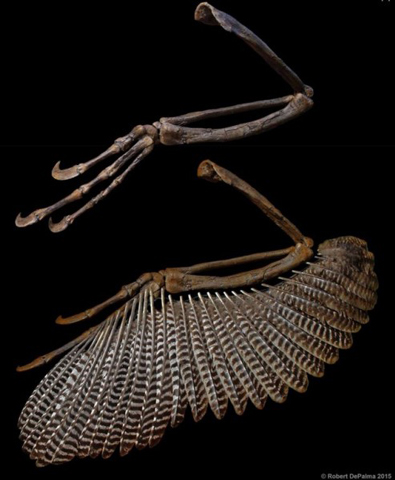Dakotaraptor steini and Niche Partitioning
An international research team which included scientists from the University of Kansas, Pete Larson (Black Hills Institute of Geological Research) and Bob Bakker (Houston Museum of Science and Nature) , have finally solved a hundred year mystery with the describing of a very large dromaeosaurid from fluvial deposits that form part of the famous Hell Creek Formation exposed in South Dakota. Teeth, very typical of a dromaeosaurid, had been found in the Late Maastrichtian deposits indicating the presence of a very large “raptor”, however, no bones to link to the teeth were known.
However, a paper published in “Paleontological Contributions” describes Dakotaraptor (D. steini) and a new super-sized Dromaeosaur has been introduced to the world.
Dakotaraptor – A Fearsome Predator
Picture credit: Emily Willoughby
Dakotaraptor
At an estimated five and half metres in length, this new meat-eating dinosaur, known from fragmentary remains representing two individuals fills a niche within the food web of the fauna represented by the vertebrate fossils associated with the famous Hell Creek Formation. A number of small theropods are known as well as the super-sized tyrannosaurs such as T. rex. Dakotaraptor represents a sort of “halfway house” when it comes to the carnivores associated with Hell Creek
Its limbs and body are very similar to the smaller dromaeosaurids known from this part of the world, dinosaurs such as Dromaeosaurus, (the first dromaeosaurid ever described), Saurornitholestes, and the recently named Acheroraptor but proportionately much larger. Dakotaraptor was one “raptor” that actually did grow to be as big as the “Velociraptors” featured in the Jurassic Park franchise.
The Beasts of the Mesozoic range includes a variety of feathered dromaeosaurid models. To view the Beasts of the Mesozoic range: Beasts of the Mesozoic Articulated Dinosaur Figures.
Commenting on the size and scale of Dakotaraptor, co-author of the publication and Kansas University palaeontologist, David Burnham said:
“This new predatory dinosaur also fills the body size gap between smaller theropods and large tyrannosaurs that lived at this time.”
Fossils Found in 2005
The fossils were found in 2005, lead author of the research, Robert DePalma, (curator of vertebrate palaeontology at the Palm Beach Museum of Natural History) led the field expedition to Harding County (South Dakota) where the specimens were located. At the time, he was a graduate student studying under former Kansas University professor and curator Larry Martin, who sadly passed away in 2014.
He explained:
“This Cretaceous period raptor would have been lightly built and probably just as agile as the vicious smaller theropods such as Velociraptor.”
As Big as the “Jurassic Park” Raptors
In addition to being roughly the size of the iconic “Raptors” from Jurassic Park, there are two very exciting skeletal features preserved in Dakotaraptor. The paper describes a massive dromaeosaur sickle claw on the middle toe. It measures 16 cm from top to bottom and 24 cm along the outer curve. This was an impressively large raptorial claw, even for an animal this size.
The ulna, a bone in the forearm, bares 15 large and distinct quill knobs, or ulnar papillae, which are reinforced attachment points on the wings of birds and other dinosaurs where the large, pennaceous feathers attach. This makes Dakotaraptor the largest known dinosaur with confirmed wings.
Reconstructed Dakotaraptor Wing and Proposed Plumage
Picture credit: Robert DePalma
Dakotaraptor may not have competed directly with adult tyrannosaurs. Perhaps it adopted a different hunting strategy or specialised in attacking a different sort of prey. By doing this it would have avoided direct competition between it and other large predatory dinosaurs. This is an example of niche partitioning.
When asked by Everything Dinosaur about this particular aspect of the research, Robert DePalma explained:
“Niche partitioning is a given, Dakotaraptor had to occupy a distinct ecological niche. If it coexisted with the other large predators, had the same herbivores available to them, and did not out compete each other to extinction, then there had to be different strategies going on.”
Everything Dinosaur acknowledges the assistance of Kansas University and Robert DePalma in the compilation of this article.








Leave A Comment